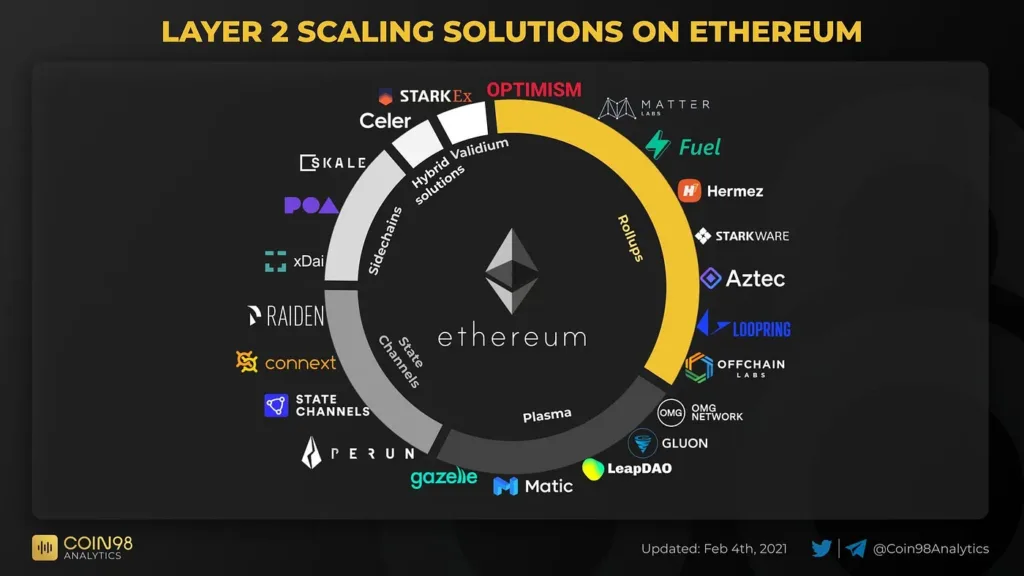Ethereum’s rapid rise has reshaped the digital landscape, but its growth isn’t without pitfalls. As its popularity soars, so does its inflationary token supply, a concern that’s becoming hard to ignore. High transaction fees and scalability issues press users to seek alternatives on Layer 2 solutions. These challenges highlight an inflation ripple effect that can’t be overlooked. Understanding how Ethereum’s success is intertwined with its shortcomings helps investors and enthusiasts navigate its complex ecosystem. This exploration of Ethereum Inflation offers insights into why many are transitioning towards more scalable options.
The Success of Ethereum: A Double-Edged Sword
Ethereum, often considered the backbone of decentralized applications and smart contracts, has achieved remarkable success over the years. However, like a double-edged sword, this growth has brought both benefits and challenges.
Interesting Read: How Blockchain Is Revolutionizing Industries Beyond Finance [2024 Update]
Ethereum’s Growth and Adoption
Ethereum’s rise in popularity can be attributed to several key factors that have captured the interest of developers and users alike:
- Decentralization and Smart Contracts: Ethereum’s platform allows developers to create decentralized applications (DApps) using smart contracts, making it an appealing choice for innovation. Unlike traditional applications, DApps offer transparency and security that central systems can’t match.
- Corporate Interest: Major corporations like Microsoft and JPMorgan Chase have invested in Ethereum’s technology, fostering an environment of trust and credibility. This has not only fueled Ethereum’s growth but has also led to significant adoption by major companies.
- Community Support: With robust community support and continuous development, Ethereum has rapidly evolved. The community’s contributions ensure that the platform remains cutting-edge and adapts to new demands and challenges.
- Innovative Use Cases: Ethereum’s flexibility has allowed it to host various applications beyond financial services, including identity verification and supply chain management.
Despite the meteoric rise, this growth is accompanied by challenges. As Ethereum continues to scale, it faces hurdles concerning scalability, security, and regulatory compliance that must be negotiated carefully.
Ethereum Inflation Mechanics
Ethereum’s transition from proof-of-work to proof-of-stake, known as “The Merge,” has significantly reshaped its inflationary dynamics. Here’s how the tokenomics have influenced Ethereum Inflation post-Merge:
- Supply Dynamics: The merge has tailored Ethereum to be less inflationary. Under proof-of-work, Ethereum’s supply increased at a higher rate, leading to an annual inflation of over 3%. Now, the shift has slowed the supply growth and is steering Ethereum towards becoming a deflationary asset over time. This change can be seen in the post-merge inflation adjustments.
- Staking Impacts: By allowing holders to earn yields through staking, Ethereum encourages holding rather than selling, which potentially stabilizes the market.
- Gas Fees and Burn Mechanism: The introduction of the EIP-1559 fee burning mechanism aims to offset new issuance and contribute to a decrease in overall supply, further tweaking the inflation rate.
These inflationary aspects pose challenges and opportunities alike. As Ethereum enthusiasts explore Layer 2 solutions to mitigate high gas fees and congestion, the platform must balance growth with sustainable economic models.
The success of Ethereum is both a testament to its technological achievements and a reminder of the ongoing challenges within the cryptocurrency space. The community continues to innovate, driving Ethereum forward while carefully navigating these double-edged dynamics.
Understanding Ethereum Inflation

Ethereum’s rapid growth has often been associated with its value and technological success. However, there’s an often overlooked aspect — its inflation ( Increase in total supply of Ethereum over time) . As Ethereum becomes more popular, the demand for its network increases, leading to inflationary pressures. But what exactly is Ethereum inflation, and how does it affect users? Let’s explore this intriguing aspect.
Current Inflation Trends
Recent trends show that Ethereum has experienced significant fluctuations in its inflation rates. Over the last quarter, Ethereum witnessed an inflationary period where its price surged dramatically.
So, why is inflation happening? Here are some key reasons:
- Increased Network Demand: As more people use Ethereum, more tokens need to be issued to miners as rewards, leading to inflation.
- Market Sentiment: Investors’ perception of Ethereum’s potential can drive buying sprees, contributing to price inflation.
- Technological Upgrades: New improvements and updates sometimes create speculative interest, temporarily inflating prices.
These factors make it essential for users to stay informed about current inflation trends, as these can signal changes in how they might use or invest in Ethereum.
The Impact of EIP-1559
The introduction of Ethereum Improvement Proposal 1559 (EIP-1559) was seen as a turning point for Ethereum inflation. This proposal aimed to stabilize transaction fees and introduce a new mechanism to control inflation by “burning” a part of the transaction fees. But how effective has it really been?
According to Galaxy Digital, EIP-1559 introduced a method to simplify gas pricing. By reducing the complexity around these fees, Ethereum could achieve a more predictable inflation rate. As observed by Bitcoin.com, the burning mechanism has indeed reduced Ethereum’s overall inflation rate, making the currency slightly more scarce over time.
Key Effects of EIP-1559 on Inflation:
- Fee Burning: Permanently removes a portion of ETH from circulation, reducing inflation.
- Stabilized Gas Prices: Creates more predictable and user-friendly fee structures.
- Long-term Deflationary Pressure: The burning mechanism exerts downward pressure on ETH supply, potentially leading to deflation over time.
Ultimately, the EIP-1559 proposal has helped moderate Ethereum’s inflation, driving the platform closer to what some experts refer to as “ultra-sound money.” While Ethereum remains inflationary, observing these changes helps users understand how Ethereum continues to adapt to its growing ecosystem.
By merging technological advancement with economic strategies, Ethereum aims to balance between its robust growth and the challenges posed by inflation, giving users more stable and predictable interactions with the network.
Migration to Layer 2 Solutions

Ethereum’s remarkable success has brought about a surge in users, which in turn has led to an inflation of its transaction fees. As the mainnet becomes increasingly congested, many are looking toward Layer 2 solutions as a way to ease the load. These solutions promise not only to reduce costs but also to enhance speed, stepping in as vital infrastructures for scalability. But why exactly are users moving to Layer 2, and what options are available for them? Let’s find out.
Why Users are Moving to Layer 2
As Ethereum’s network balloons with success, so too do its challenges. The primary allure of Layer 2 solutions lies in their ability to tackle two critical issues faced by Ethereum users: high transaction fees and slow processing times.
- Reduced Transaction Costs: Ethereum’s gas fees can skyrocket during peak usage periods. Many users face exorbitant costs that make small transactions economically unfeasible. By migrating to Layer 2, transaction costs can drastically fall, allowing users to execute transactions without the worry of spending more on fees than on the transaction itself.
- Improved Speed: Just as a busy highway slows down traffic, Ethereum’s congestion leads to slower transaction confirmations. Layer 2 solutions, acting like express lanes, provide faster processing by handling transactions off the main chain and only recording when necessary. This enhancement in speed makes the user experience smoother, drawing in more participants.
The recent rise in Ethereum inflation has amplified the need for cost-effective solutions, cementing Layer 2 as a popular choice among users.
Layer 2 Solutions Overview
Layer 2 solutions are becoming the talk of Ethereum’s ecosystem. Among them, Optimism and Arbitrum shine as prominent players. But what makes these solutions stand out?
- Optimism: Known for its optimistic rollups, Optimism allows for scaling without compromising Ethereum’s security. It processes transactions off-chain and submits data back to Ethereum, achieving both cost savings and security. Explore more about Optimism.
- Arbitrum: This solution also uses rollups to achieve scalability. Its ability to handle smart contracts efficiently while keeping costs low makes it especially attractive to developers and businesses. Arbitrum is heavily favored for applications requiring fast transactions. Learn about Arbitrum’s capabilities.
These solutions not only tackle the pressing issues but also empower Ethereum applications to function smoothly on a larger scale. As the market adapts to Ethereum’s ongoing success and challenges, Layer 2 solutions will likely play a pivotal role in shaping its future.
In a digital landscape where speed and cost reign supreme, the migration to Layer 2 solutions echoes the relentless pursuit of efficiency, embodying a stride toward sustainable growth in Ethereum’s bustling ecosystem.
Challenges Posed by Layer 2 Solutions
Ethereum’s rise to prominence has not come without its challenges. As it continues to gain traction, the network faces hurdles that affect both developers and users, particularly through its Layer 2 solutions. These solutions aim to improve scalability and reduce costs, but they also bring about their own complexity and security issues.
Complexity and User Experience
Layer 2 solutions attempt to alleviate Ethereum’s congestion by processing transactions off the main chain, allowing for faster and cheaper transactions. However, this added layer comes with its own complexities. Imagine trying to juggle too many balls at once; the more balls added, the harder it becomes to keep track.
- User Interfaces: The interfaces for Layer 2 solutions can often be tricky for new users, leading to confusion. Unlike traditional apps, engaging with these solutions can require specialized knowledge.
- Adoption Rates: Complexity can directly influence adoption rates. If users find the solution hard to navigate, they might simply choose not to use it. For broad acceptance, simplicity is key.
For developers and users, the intricacy of the Layer 2 environment can act as a roadblock to reaching mainstream success. As Ethereum’s network grows, simplifying the user experience should be a top priority to overcome these hurdles.
Security Concerns
While Layer 2 solutions promise to enhance the scalability of Ethereum, they also introduce new security challenges. Picture a house with multiple doors; each additional door provides a new entrance that could potentially be breached.
- Vulnerable Points: With the integration of Layer 2 solutions, there are more interfaces that require security audits and protocols. Each additional layer or checkpoint can act as a potential vulnerability.
- Trust Issues: Many Layer 2 solutions depend on trust assumptions that are different from Ethereum’s main chain. This can include centralized operators, which may contradict the decentralized ethos that Ethereum upholds.
Security is crucial in protecting the integrity of Ethereum’s ecosystem. Without robust security measures, the risks associated with Layer 2 solutions might outweigh the benefits, creating new avenues for breaches.
Ethereum is at a crossroads. While Layer 2 solutions offer needed improvements, they also pose significant challenges that must be addressed. As Ethereum’s success continues, understanding these obstacles is vital for a robust and sustainable future.
Future Outlook for Ethereum
Ethereum’s journey has been nothing short of a roller coaster. It’s seen highs that have left investors cheering in delight, and lows that have made them question their faith in crypto. But what’s next for this digital titan? Exploring the future of Ethereum requires sifting through its current challenges and preparing for what’s to come. With inflationary pressures creeping into the system, the community’s role in governance and decision-making becomes ever more critical.
Potential Solutions to Manage Inflation
As Ethereum advances, the challenge of managing its inflationary pressures becomes increasingly significant. With network activity affecting the balance of Ether burned versus issued, the community is thinking of various approaches to tackle these concerns.
- Enhanced Layer 2 Solutions: Ethereum is already exploring Layer 2 networks that may help control the inflationary rates by improving transaction efficiency. According to 21Shares, these technologies can streamline processing times, ultimately leading to less strain on Ethereum’s main network.
- Token Holder Votes: Allowing token holders to participate in voting can maintain a sustainable inflation rate. This method is already being examined, with a potential annual inflation rate being decided by token holder votes, thereby giving the community a direct voice in financial decisions.
- Technological Upgrades: Possible technical upgrades, such as the implementation of Ethereum Improvement Proposals (EIPs), continue to be vital in managing inflation. Recent changes have influenced inflationary trends, as illustrated by the Dencun upgrade that has shifted the financial balance.
Conclusion
Ethereum’s success has inadvertently led to an inflationary token supply, raising concerns among users and investors. The rise in Ethereum inflation is a byproduct of its widespread adoption and network congestion, driving the shift toward Layer 2 scaling solutions.
These alternative solutions, while effective in reducing transaction costs and increasing speed, have introduced complexities in Ethereum’s ecosystem, challenging its traditional tokenomics.
For Ethereum’s community, this development necessitates a balancing act, ensuring that Ethereum inflation does not undermine future growth prospects.
Reflecting on these dynamics encourages a closer examination of the implications for long-term investment strategies.
To foster a deeper understanding, readers are urged to contemplate the ongoing transformation and explore how Layer 2 adoption might continue to reshape Ethereum’s trajectory.













